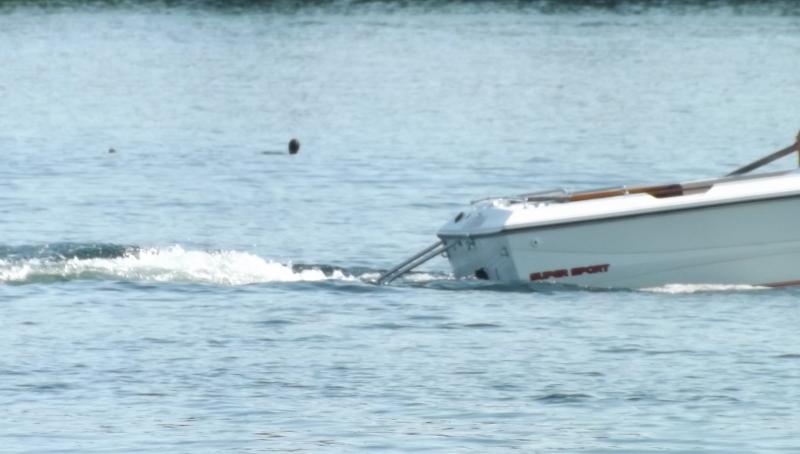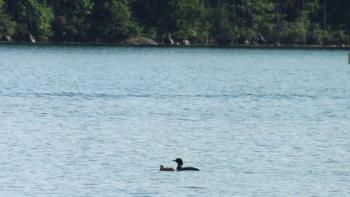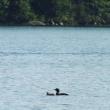A mother’s anguish
Like many people dealing with the recent heat, we elected on a recent weekend afternoon to cool ourselves in one of the lakes that we in Maine are blessed with. We stopped at Lake St. George State Park in Liberty, on our way to Camden. The water was just as we expected — clear and refreshing — and as we always do, we also kept an ear and eye out for birds. It wasn’t long before we spotted a loon swimming in across the lake toward the roped-off swimming area, with another half-sized loon following closely behind. This was good news for bird lovers — and loon lovers — as it was a mother loon with a chick!
But our joy turned quickly to anxiety as a speeding boat with a water skier in tow zoomed past her and the chick. You can see a video clip posted with this article at www.boothbayregister.com.
After the boat passed by, she resumed her foraging. After several short dives, she came up with small minnows to feed her little one. But again, a speeding boat passed her. Then an overloaded canoe came in on one side of her while a kayaker prevented her escape on the other. She reared up, flapping her wings and calling, obviously distressed but unwilling to leave her chick, still flightless and apparently still too young to dive.
We hollered to the paddlers and waved them off, and they moved on, but boat after boat passed by as she tried to feed her chick and keep it from being mowed over by an unsuspecting, unknowing (hopefully not uncaring!) pleasure boater. We held our breath and watched helplessly as the poor mother loon struggled for the survival of her one and only offspring.
Eventually she was able to thread a path through the boat traffic to the other side of the lake, which was quieter, which gave us some hope. But imagining her trying to shepherd her chick through that kind of human onslaught for the weeks required to bring the baby bird to independence seemed almost unimaginable.
There is little doubt that the more human development around the shores of a lake — and the accompanying human recreational use — the more likely it is that loons will eventually disappear as nesting species on the lake. This is not only because of the kind of on-the-water activity we saw on Lake St. George, but also the lack of undisturbed shoreline nesting sites.
What often follows is a change in water quality, which leads to changes in species and abundance of various fish and invertebrates. Sadly, there are a lot of things that can go wrong when a pair of loons is trying to bring a new loon into the world.
Because loons are long-lived once they reach adulthood, even if the population is ultimately doomed due to unsuccessful reproduction, a particular lake or group of lakes may have adult loons on them for many years.
The presence of these adult loons may hide the fact that the lake is no longer healthy enough to support a loon population that is replacing itself. When loons no longer breed there and there are more non-native and stocked fish than naturally occurring and self-sustaining ones, then we’ve effectively turned the lake into a glorified swimming pool for humans to use to play in their leisure time.
If the world wants to continue to have loons, then we must protect lakes in their breeding range, keeping pristine ones undeveloped and lightly used. On more developed lakes, we must find ways to leave areas on shore for them to nest and on the water to feed undisturbed.
And we need to do more to make recreational boaters and others who use lakes understand and care when they are disturbing loons by approaching too close, driving too fast and recklessly, and polluting and changing the aquatic ecosystems in the lakes that we all love — sometimes literally loving them to death.
Event Date
Address
United States




























